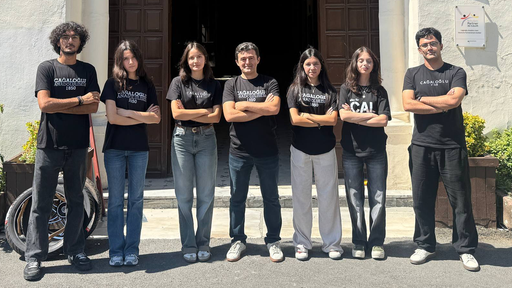She described CERN as a place of “incredible scientific circulation,” where dozens of experiments run simultaneously. Having the opportunity to conduct their own experiment on a real particle accelerator in a space reserved entirely for them was, in her words, “an opportunity very few people can ever have.”
The experience, she added, was “life-changing and priceless,” not only for the scientific knowledge gained but also for the connections made and the glimpse it gave them into the lives of professional physicists.
That sense of transformation was echoed by 17-year-old Ela Kirdemir, who spoke of the project’s long-term impact. The data they collected, she noted, would be written up and, with CERN’s support, turned into a scientific paper.
For students of their age, this was a remarkable achievement. But Ela insisted that the publication was not the end point; rather, it was “a stepping stone” toward their broader ambitions, part of a clear trajectory involving both national and international competitions.
Behind this success stood their coaches, including chemistry teacher Osman Turcan and biology teacher Gokhan Gunduz, who helped the students contextualise the science.
Gunduz explained that by accelerating particles from the atom’s nucleus and colliding them at high energies with other nuclei, new particles were produced, with potential applications ranging from reducing the harmfulness of radioactive substances to exploring the very nature of matter.
Gunduz also underlined the significance of the students’ achievement for the country as a whole. This was not just the success of a school club, he stressed, but “a huge achievement for all of Türkiye.” In his view, the victory provided a roadmap for the many talented Turkish students in physics, inspiring future cohorts to follow in their footsteps.
It is striking how the students viewed the competition not as an isolated experience but as a platform for future growth. Baran, Defne, Emir, Ela, and their teammates consistently framed their success as part of a continuum, something that would shape their careers and encourage others.
Their reflections suggest that the greatest value of BL4S lies not only in the scientific experiments carried out but also in the cultivation of confidence, identity, and purpose among young scientists.
The impact is also symbolic. CERN, long regarded as a pinnacle of global collaboration in science, opened its doors to teenagers from Istanbul who, in turn, demonstrated that scientific excellence is not bound by geography or resources.
The PhysiCal team’s victory carries the weight of being a “first” for Türkiye, but the students themselves seem more focused on what comes next than on resting on laurels.
Their experience highlights the importance of giving young people platforms where they are not passive learners but active contributors to knowledge. The fact that their work will be published in a scientific journal underscores the legitimacy of their contributions.
And perhaps most importantly, the students’ voices reveal how an experience like this can be “life-changing” — not simply because of the science, but because of the recognition that they too belong in the pursuit of knowledge at the highest level.

